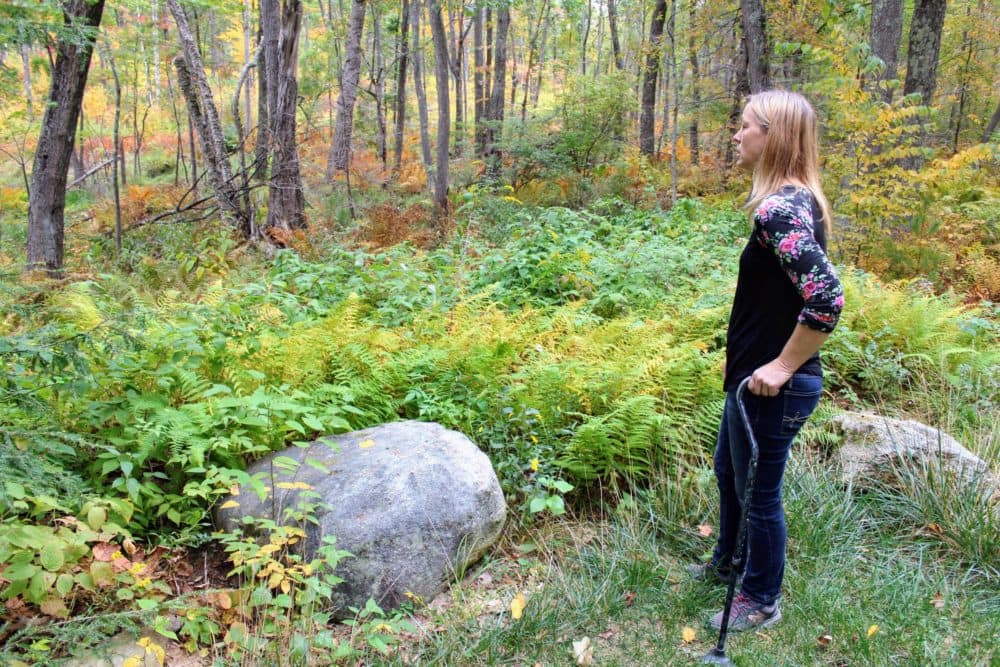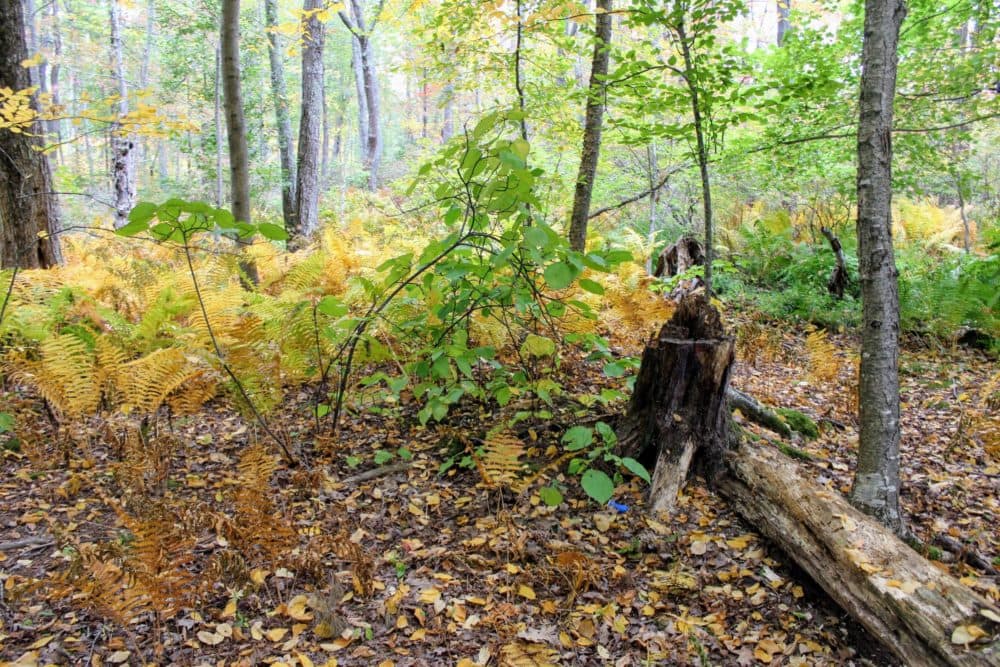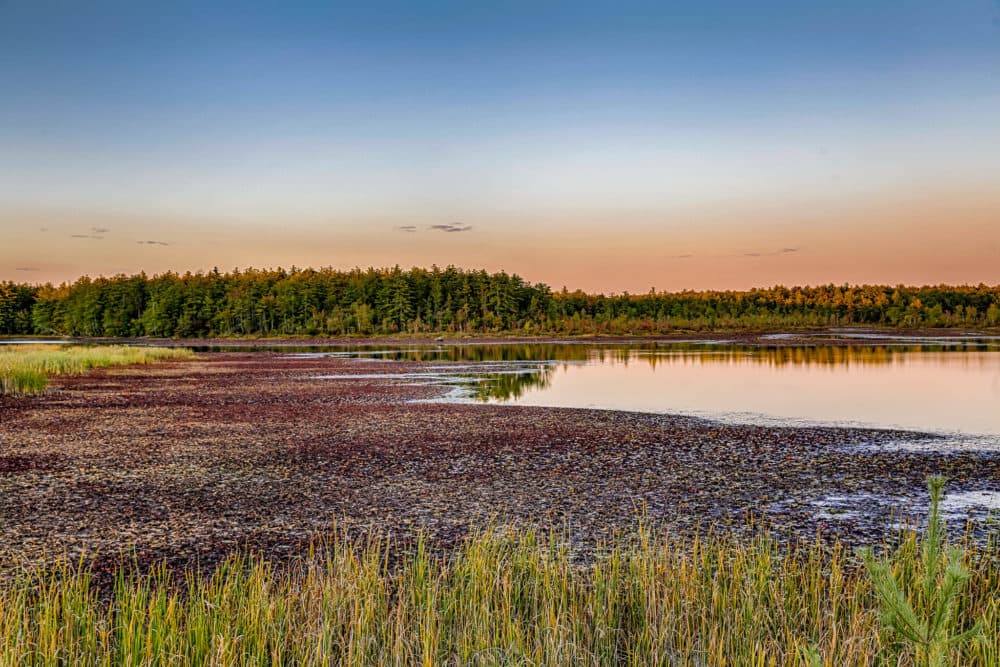Advertisement
As Climate Change Drives Droughts, Water Conservation And Infrastructure Are Key
Resume
The bog behind Jen Kippin's house in Hooksett, New Hampshire, has never been this dry. Normally there’s ducks and frogs, and enough mud and water for her grandsons to lose their sneakers in. But right now, it’s just a lot of dying plants.
"This should all be water, all of it," she said, pointing out at what looks like dry woods. "As you can see, all these yellow ferns, green ferns — there's no water, there's none."
New England didn't get much snow last winter, and this summer was hotter than average with very little rain. Conditions aren't improving. The hotter temperatures of a changing climate could make droughts like this year's more likely in the future.
Kippin's well is starting to run dry — the water in her house is coming out gritty and orange, clogging up her filters.
She said dealing with this has been exhausting, especially with extra kids and adults living in the house due to the pandemic. They've bought bottled drinking water, cut back on baths and showers, and even began taking their laundry to the local laundromat.
It's made her think about how, normally, people in New Hampshire take their water for granted.
"We can turn on the faucet and water comes out, and we don't give much thought of where it's coming from," Kippin said. "But it does get concerning when you turn on the shower and sediment comes out. Now you have to be more conscious."

Kippin is facing a tough choice about where to get water if the drought doesn't ease up.
"To drill a well? Thousands of dollars, handed over, one-time, and I don’t have that," she said. "I don't know financially what we're going to do. I don't even know how much it’ll cost to get water trucked in in a holding tank ... so for now we're just praying for the best. Praying for some rain."
What little rain is forecast all across New England in the next few weeks likely won't be enough to end the region's drought. And New Hampshire state climatologist Mary Stampone says this will keep happening as the world gets warmer — even as the Northeast gets wetter.
"Yeah, this is complicated," Stampone said. "We are still getting wetter, but the problem is we're getting more of that precipitation in larger storms. … But we're still also getting warmer. And so in the summer months, we have those warmer temperatures that can extract more water from the soil.
"So if we happen to have a dry, warm season, the warmer temperatures make that dryness more intense," she said, "leading to these sort of more frequent short-term drought conditions while the rest of the year is wet."
Plus, the increasingly heavy, sporadic rains are often too much for dry ground to absorb, causing excess runoff or even floods without recharging the groundwater for longer-term use.
Overall, Stampone said there isn't a lot of research about drought in the Northeast. She's also an associate professor at University of New Hampshire, and she's working on studying how drought relates to this region's changing winter snowpacks.
But one thing is clear: climate change makes it more likely that rain will be inconsistent, and that dry spells will worsen into droughts.
"Buying a fire extinguisher when your house is on fire makes no sense. Buying a fire extinguisher ahead of time is how you save your house. ... Conserve now, because conserving after the well goes dry doesn't do you any good at all."
Tom O'Donovan
So how can New England be better prepared — especially the majority of residents in states like New Hampshire who rely on either private or public wells? Stampone says we need to change some habits around water.
"I personally would recommend conservation," she said. "Especially in the late spring and early summer months… because by the time a drought is declared, a lot of those things that would have given you another month of water, maybe — that time is already gone."
New Hampshire Department of Environmental Services water division director Tom O'Donovan puts it another way: "Buying a fire extinguisher when your house is on fire makes no sense. Buying a fire extinguisher ahead of time is how you save your house," he said. "This is exactly what's going on with droughts. Conserve now, because conserving after the well goes dry doesn't do you any good at all."

He said conservation can be proactive: It can mean investing ahead of time in low-flow toilets and showerheads, fixing leaks, or drought-hardy landscaping that needs less irrigation.
And there are other, bigger ways to prepare. After a similarly severe drought hit much of New England in 2016 — the hottest year ever recorded on Earth — O'Donovan says lots of people deepened their private wells, and so are more protected this time.
It's the same idea for public water systems, where O'Donovan says redundancies are key — like the state's Southern New Hampshire Regional Water Interconnection Project. The massive new pipeline is linking some well users and smaller systems to a major reservoir, using nearly $40 million in MtBE contamination settlement funds from Exxon.
"It was designed to move water to areas where water was not available because it was contaminated — serves exactly the same purpose when water's not available," O'Donovan said. "So those sort of interconnected approaches are something that we in the department feel is a very, very good investment in resiliency for our communities."
But money isn't the only obstacle to resilience. The only wells in the town of Plymouth, New Hampshire, date to the 1950s, and are at risk from droughts, floods and contamination ever since the state built Interstate 93 a few hundred feet away.
Plymouth Village Water District superintendent Jason Randall said they spent 50 years looking for a suitable spot for a new well, and are still waiting on permits to start drilling.
"It'll be the first time in close to 60, 70 years that we've had a back-up source for water," he said.
Local water officials like Randall say keeping clean water flowing to people's homes is complicated and expensive — even in the best of times.
With more droughts and other risks on the rise, the cheapest way to ensure the state will have enough water is to just use less of it.
This story is a production of the New England News Collaborative. A version was originally published by New Hampshire Public Radio.
This segment aired on October 16, 2020.